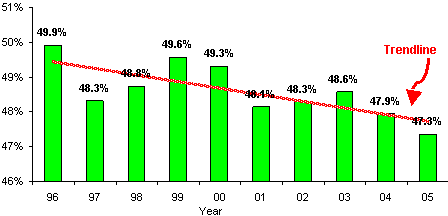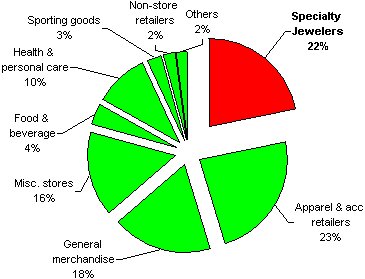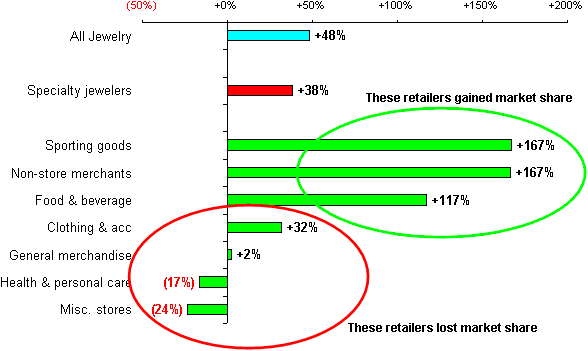IDEX Online Research: Specialty Jewelers Are Losing Market Share
March 23, 06
Specialty jewelers who lament that they are losing sales to discounters, department stores, and many other retail categories are correct. Just-released information from the U.S. Department of Commerce reveals that for every specialty jeweler in the U.S., there are three other merchants – whose primary business is not jewelry – who are also selling diamonds, precious metals, and other goods that have traditionally been the domain of specialty jewelers.
There are just over 128,000 retailers in the U.S. who sell jewelry in their stores, according to the latest Business Census data from the U.S. Department of Commerce. Roughly 28,000 of those stores, or about 22 percent of all jewelry retail outlets, are specialty jewelers; the others represent a wide variety of retail categories including department stores, general merchandise stores, warehouse clubs, apparel retailers, non-store retailers, and a number of other specialty retailers. The graph below illustrates the mix of specialty jewelers to total retailers of jewelry in the U.S.
| Stores Selling Jewelry by Category |
Because jewelry is such an attractive industry – gross margins are healthy and the long term characteristics of demand are positive – there are many merchants who are trying to sell jewelry.
Further, as a result of few barriers to entry, retailing attracts a large number of merchants who will try to sell anything to make a profit.
Specialty Jewelers Losing Market Share
The bad news for specialty jewelers is that they are losing market share to those merchants whose business is not primarily selling jewelry. Over the past decade, specialty jewelers’ market share in the U.S. has dropped from about 50 percent to just over 47 percent, as the graph below illustrates.
U.S. Specialty Jewelers’ Market Share

Source: Dept. of Commerce
Who Is Taking Market Share From Jewelers?
There may be some surprises among the list of retailers who are gaining – and those who are losing – market share in the jewelry category. As expected, non-store retailers have among the strongest growth of any retail category. Stores that retail sporting goods, hobby supplies, books, and music (a single category, according to the Department of Commerce) have also posted strong jewelry sales gain, though this category generated an aggregate of just over $100 million in sales. That was just enough to be included on our list, which analyzes only retail categories with $100 million or more in annual jewelry sales.
A graph of those retail categories that are gaining market share and those which are losing market share is shown below. These are all of the retail categories which report that they have $100 million or more of jewelry sales annually.
| Who Is Taking Jewelry Market Share? |
Who Sells Jewelry In the U.S.?
In addition to the list of logical purveyors of jewelry, there are a number of surprises on this list of jewelry outlets. For example, the Commerce Department’s Business Census, lists 117 stores which primarily sell beer and wine that also sell jewelry. You can gas up your car at 178 gasoline stations that also sell jewelry. In addition, there are about 385 convenience stores (such as 7-Eleven) which sell jewelry; 1,210 book stores sell jewelry; and, 37 pet stores also sell jewelry. In the prior Business Census (1997) about 85 automobile dealers also sold jewelry; by 2002, however, those car dealers apparently had stopped selling gemstones and watches.
Here’s an exhaustive list of all merchants who sell jewelry, but whose primary product line is not jewelry.
- Furniture & furnishings stores
- Consumer electronics stores
- Appliance stores
- Home centers, including building materials, lawn & garden supplies, nurseries, farm supply and hardware stores
- Grocery stores, supermarkets, convenience stores
- Fruit, vegetable, confectionery, and nut stores
- Beer, wine, and liquor stores
- Cosmetics, beauty supplies, and perfume stores
- Optical goods stores
- Gasoline stations
- Clothing stores, including men’s wear, women’s wear, children and family clothing, shoe stores, and infants’ stores
- Luggage and leather goods stores
- Sporting goods, hobby, and musical instrument stores
- Sewing, needlework, and piece goods shops
- Book stores, news dealers, college book shops
- Music stores
- Department stores
- Warehouse clubs
- Variety stores
- Florists
- Office supply, stationery, and gift shops
- Used merchandise stores (pawn shops are included in this category)
- Pet stores, art dealers, tobacco stores
- Electronic shopping and mail-order retailers
- Vending machine operators and direct selling, including in-home sales
IDEX Online Research maintains a complete list of the Department of Commerce Business Census data for the past three surveys, including the number of retailers in each category, their employment, their sales, and other data. This data is also available by state and metro area. Additional information is available for a fee.

